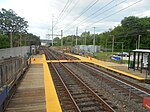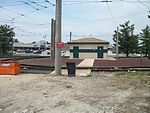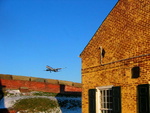Philadelphia International Airport (IATA: PHL, ICAO: KPHL, FAA LID: PHL) is the primary airport serving Philadelphia, Pennsylvania. The airport serves 31.7 million passengers annually, making it the 21st busiest airport in the United States. In 2019, PHL served 33,018,886 passengers, the most in the airport's history. The airport is located 7 miles (11 km) from the city's downtown area and has 22 airlines that offer nearly 500 daily departures to more than 130 destinations worldwide.Philadelphia International Airport is the largest airport serving the state of Pennsylvania. It is the fifth-largest hub for American Airlines and its primary hub for the Northeastern United States, as well as its primary European and transatlantic gateway. Additionally, the airport is a regional cargo hub for UPS Airlines and a focus city for the ultra low-cost airline Frontier Airlines.
The airport has service to cities in the United States, Canada, the Caribbean, Latin America, Europe, and the Middle East. As of summer 2019, there are flights from the airport to 140 destinations, 102 domestic and 38 international. Most of the airport property is in Philadelphia proper. The international terminal and the western end of the airfield are in Tinicum Township, Delaware County. PHL covers 2,302 acres (932 ha) and has four runways.Philadelphia International Airport is important to Philadelphia, its metropolitan region and the Commonwealth of Pennsylvania. The Commonwealth's Aviation Bureau reported in its Pennsylvania Air Service Monitor that the total economic impact made by the state's airports in 2004 was $22 billion. In 2017, PHL commissioned a new economic impact report. The report found PHL alone accounted for $15.4 billion in activity with over 96,000 direct and indirect jobs with $5.4 billion in total earnings.










